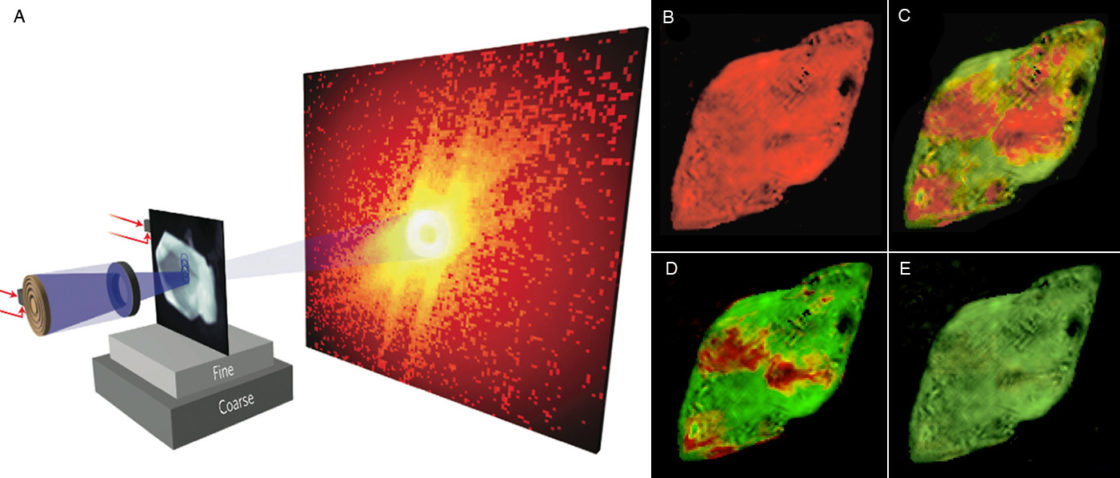To realize critical advances in synchrotron-enabled science requires a new generation of storage-ring-based light sources capable of providing two critical ingredients:
- soft x-ray light, which has the appropriate photon energy to interact strongly with the electrons that determine the chemical, electronic, and magnetic properties of materials, and
- high coherent flux delivered in a nearly continuous wave, which is necessary to resolve nanometer-scale features and interactions and which allows real-time observation of chemical processes as they evolve and of materials as they function.
Building on soft x-ray techniques developed at ALS and other light sources over the last two decades, x-ray beams at the upgraded ALS will provide three crucial interrelated characterization capabilities:
- imaging heterogeneous chemical, electronic, and magnetic structures in three dimensions with a spatial resolution of nanometers to many microns;
- measuring the interaction of coupled kinetic processes within these hierarchical structures with a resolution of nanoseconds to seconds; and
- detecting with high precision and sensitivity the structure and dynamics of atoms, ions, molecules, spins, and defects.

These capabilities will dramatically expand the ability of researchers to study hierarchical chemical and material structures that support interacting processes across broad time and length scales. By combining detailed spatial characterization with the simultaneous ability to monitor a system as it functions and evolves over time, the renewed ALS will open doors to a broad range of exciting new science opportunities.
New Tools to Tackle Critical Challenges
To address critical challenges in matter and energy, scientists want to learn how to assemble material and chemical nanostructures that mimic the highly efficient way in which biological and environmental systems function. The upgraded ALS can play a key role in this effort by building upon existing soft x-ray tools to measure nanomaterials in diverse functioning environments. For example, the future facility’s enhanced beams will increase our knowledge of catalytic reaction mechanisms at the atomic scale and thereby will enable the design of energy efficient and highly selective catalytic reactors.
The stable, nearly continuous-wave, high coherent flux, soft x-rays from the upgraded ALS will also enable researchers to study and understand material compositions and processes at their inherent length and time scales, extending from microns to nanometers and from seconds to nanoseconds. For example, with the enhanced capabilities enabled by ALS-U, experiments employing advanced 3D x-ray imaging techniques will allow the measurement 3D chemical maps with unprecedented resolution. Such maps, among other possibilities, will lead to substantial improvements in the performance and lifetime of electrochemical systems like batteries and fuel cells.

Another category of experiments that will be made possible by ALS-U involves material dynamics and kinetics to study the flow of energy and charge in chemical systems, ranging in complexity from a single atom to clusters and ensembles of solvated and surface-bound molecules. Such studies are crucial to the goal of controlling chemistry at the nanoscale with potential applications in energy storage systems as well as artificial photosynthesis and other carbon-neutral energy technologies that act to mitigate climate change.
Quantum materials are a topic of keen interest to the DOE Office of Science and the global electronics industry because their unique blend of novel optical, electronic, and magnetic properties promises an immense range of energy efficient functionalities. ALS soft x-ray users have had a huge impact in understanding the intriguing emergent properties like high temperature superconductivity exhibited by spin and quantum materials. However, progress in developing useful technologies based on these materials has been slow, due in part to the difficulty of probing them in functioning sub-micron structures using the same powerful suite of soft x-ray tools. ALS-U will transform soft x-ray spectroscopy tools into powerful nanoprobe techniques with spectroscopic contrast such as resonant inelastic x-ray scattering (nanoRIXS) and angle-resolved photoemission spectroscopy (nanoARPES). For example, ALS-U could revolutionize the study of skyrmions, nanoscale quasiparticles poised to play a key role in future spintronic technologies.
For the study of soft and biological materials, the high-brightness and coherent x-ray beams of the upgraded ALS will provide a huge dynamic range in both space and time that promises to significantly enhance our understanding of key properties including self-assembly, emergent behavior, and adaptation to environmental changes.
Leveraging Institutional Capabilities and Expertise
The upgraded ALS will benefit from the many outstanding research programs at Berkeley Lab, including in its Chemical and Materials Sciences Divisions and its Biosciences, Earth and Environmental Sciences, and Energy Technology Areas. The ALS is also strongly connected to other exceptional LBNL user facilities such as the Molecular Foundry, which includes the National Center for Electron Microscopy (NCEM), and the National Energy Research Scientific Computing Center (NERSC). Many of the research programs at these facilities either depend directly upon access to the ALS or interact synergistically with programs that use the ALS. The transformative level of characterization made possible with ALS-U—coupled with Berkeley Lab’s strong theory and materials synthesis efforts within the Center for Advanced Mathematics for Energy Research Applications (CAMERA), the Materials Project, and the Molecular Foundry—will enhance the community’s abilities to address major challenges associated with the US federal government’s Materials Genome Initiative in unprecedented fashion. This should accelerate the discovery of new functional materials and phenomena of relevance to energy applications.